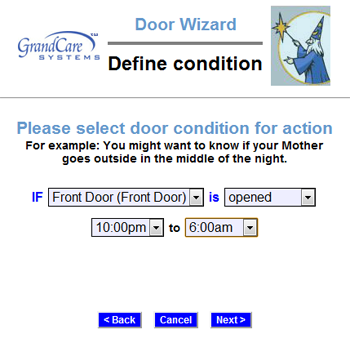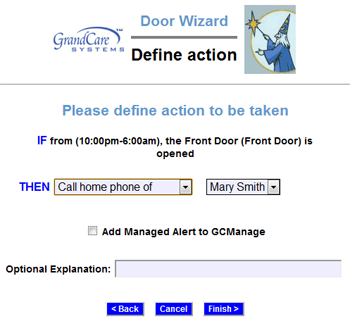Difference between revisions of "Action Buttons"
| Line 2: | Line 2: | ||
[[File:InovonicsPendant.png|right|frame|Inovonics Push-Button Pendant]] | [[File:InovonicsPendant.png|right|frame|Inovonics Push-Button Pendant]] | ||
<h3 style="display: inline-block; background:#ffffff; font-weight:bold; border-bottom:2px solid #6093cc; text-align:left; color:#000; padding:0.2em 0.4em;"><br />Overview</h3> | <h3 style="display: inline-block; background:#ffffff; font-weight:bold; border-bottom:2px solid #6093cc; text-align:left; color:#000; padding:0.2em 0.4em;"><br />Overview</h3> | ||
The simplest type of sensor is the | The simplest type of sensor is the action button or pendant. It is a device with a button that can be pushed at any time. These devices can be placed in a convenient spot, or worn like necklace. Rules can be set to send out notifications when the button is pushed. The notifications can be sent by email, text, or phone, and can go to a single caregiver or to many. Sometimes referred to as "Call Me" buttons, these devices can let you know when your loved one needs some help, or needs you to call.<br /><br /> | ||
[[File:DoorRuleCondition.png|right|frame|Define a Door Rule Condition]] | |||
[[File:DoorRuleAction.png|right|frame|Define a Door Rule Action]] | |||
<h3 style="display: inline-block; background:#ffffff; font-weight:bold; border-bottom:2px solid #6093cc; text-align:left; color:#000; padding:0.2em 0.4em;">Setting Rules</h3> | |||
You can set up rules to alert caregivers when something occurs. To add a rule: | |||
* [[Logging In|Log in to GCManage]] | |||
* Open the [[Care Menu|Care Menu]] | |||
* Click the "Notifications" button | |||
* In the Action Button Rules section, click the "Add New Rule" button<br /><br /> | |||
There are two parts to each rule, a condition and an action. On the first screen, define the condition. Your rule can be triggered when a door is: | |||
* Opened | |||
* Opened the next time | |||
* Left open | |||
* Closed<br /><br /> | |||
Depending on the condition, the rule can be set to detect door activity at a particular sensor, or at any single sensor.<br /><br /> | |||
You can choose a time period during which the rule would execute, for example for a time period at night, for a time period around lunchtime, etc. You can also specify how frequently to check the condition, or in some cases how long the condition must continue before an alert is triggered.<br /><br /> | |||
Examples of conditions might be: | |||
* If the back door opens after dark, turn on the back yard light. | |||
* If any door opens in the middle of the night, phone the next door neighbor to intervene. | |||
* If the front door opens in the middle of the morning, then send an email to a caregiver because a service provider has arrived.<br /><br /> | |||
Once you have defined the condition, you need to set the action. Possible actions include turning on a light, or contacting a single caregiver, all caregivers, or a [[Call List|Call List]]. The types of contact include: | |||
* Email | |||
* Text message | |||
* Turn on a light | |||
* Phone call to home, work or cell phone | |||
* Phone call to a [[Call List|Call List]]<br /><br /> | |||
Multiple rules can be triggered for any event, so that multiple types of alerts can be sent out, for example both phone calls and emails.<br /><br /> | |||
A checkbox next to the rule lets you set whether the rule is enabled or disabled. It might make sense to turn off a rule while your loved one is on vacation, so that alerts won't be sent out during that time. You can disable a rule by unchecking the box. When you're ready for the rule to be active again, just check the Enabled checkbox again, and then save the rule settings. | |||
Revision as of 16:29, 15 June 2012
Overview
The simplest type of sensor is the action button or pendant. It is a device with a button that can be pushed at any time. These devices can be placed in a convenient spot, or worn like necklace. Rules can be set to send out notifications when the button is pushed. The notifications can be sent by email, text, or phone, and can go to a single caregiver or to many. Sometimes referred to as "Call Me" buttons, these devices can let you know when your loved one needs some help, or needs you to call.
Setting Rules
You can set up rules to alert caregivers when something occurs. To add a rule:
- Log in to GCManage
- Open the Care Menu
- Click the "Notifications" button
- In the Action Button Rules section, click the "Add New Rule" button
There are two parts to each rule, a condition and an action. On the first screen, define the condition. Your rule can be triggered when a door is:
- Opened
- Opened the next time
- Left open
- Closed
Depending on the condition, the rule can be set to detect door activity at a particular sensor, or at any single sensor.
You can choose a time period during which the rule would execute, for example for a time period at night, for a time period around lunchtime, etc. You can also specify how frequently to check the condition, or in some cases how long the condition must continue before an alert is triggered.
Examples of conditions might be:
- If the back door opens after dark, turn on the back yard light.
- If any door opens in the middle of the night, phone the next door neighbor to intervene.
- If the front door opens in the middle of the morning, then send an email to a caregiver because a service provider has arrived.
Once you have defined the condition, you need to set the action. Possible actions include turning on a light, or contacting a single caregiver, all caregivers, or a Call List. The types of contact include:
- Text message
- Turn on a light
- Phone call to home, work or cell phone
- Phone call to a Call List
Multiple rules can be triggered for any event, so that multiple types of alerts can be sent out, for example both phone calls and emails.
A checkbox next to the rule lets you set whether the rule is enabled or disabled. It might make sense to turn off a rule while your loved one is on vacation, so that alerts won't be sent out during that time. You can disable a rule by unchecking the box. When you're ready for the rule to be active again, just check the Enabled checkbox again, and then save the rule settings.



